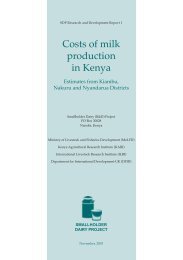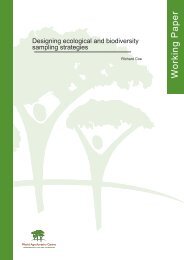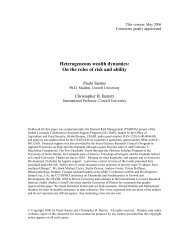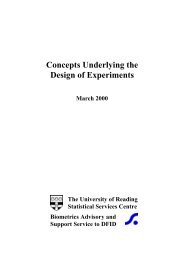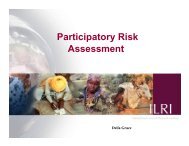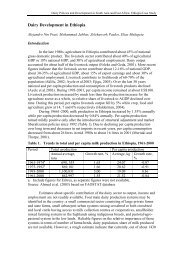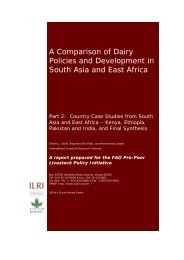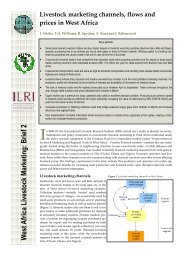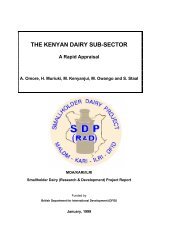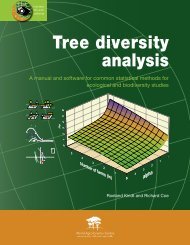decl<strong>in</strong><strong>in</strong>g soil fertility reduce yields. The soil is left fallow for four to ten years, which allows for the regrowth<strong>of</strong> forest species and the restoration <strong>of</strong> soil fertility. However, the fallow periods that once lasted 10–40 yearsare be<strong>in</strong>g reduced <strong>in</strong> most countries due to <strong>in</strong>creas<strong>in</strong>g population pressure. This development significantlyaffects the restoration <strong>of</strong> soil fertility.Land degradation has occurred <strong>of</strong>ten <strong>in</strong> the humid tropics when shift<strong>in</strong>g cultivation is practised bymigrants, with little experience <strong>of</strong> the system or soil conservation, and the land is left devoid <strong>of</strong> vegetationfor a considerable time. Under these conditions, there has been major erosion <strong>in</strong> hilly areas and siltation <strong>of</strong>rivers. In the Philipp<strong>in</strong>es, soil erosion is a serious problem <strong>in</strong> areas with roll<strong>in</strong>g to steep slopes and is enhancedwhere upland rice is grown. Shift<strong>in</strong>g cultivation <strong>in</strong> these hilly areas causes average annual soil losses <strong>of</strong> 100t/ha. However, trials by Labios et al (1995) on slop<strong>in</strong>g land showed that, over two years, average soil lossesfrom the use <strong>of</strong> alley-cropp<strong>in</strong>g with Flem<strong>in</strong>gia macrophylla was only 42.4 m 3 /ha compared to 139.6 m 3 /haunder farmer practice without contour hedgerows. Rice yields were highest <strong>in</strong> the alley-cropp<strong>in</strong>g system. Therisk <strong>of</strong> erosion is much greater <strong>in</strong> the humid zone than <strong>in</strong> the sub-humid zone as a result <strong>of</strong> higher <strong>in</strong>tensityra<strong>in</strong>fall.<strong>Animal</strong> production systems<strong>Animal</strong> production systems <strong>in</strong>volve both rum<strong>in</strong>ants and non-rum<strong>in</strong>ants, and systems <strong>in</strong>tegrat<strong>in</strong>g crops andanimals occur throughout South-East Asia. These have considerable potential for further improvement andthe benefits are associated with complementary <strong>in</strong>teractions between sub-systems (e.g. crops, animals or fish)<strong>in</strong> which the products are additive (Edwards et al 1988). Two examples <strong>of</strong> such <strong>in</strong>tegrated systems, theireconomic benefits and contribution to susta<strong>in</strong>ability are given by Devendra (1993). These arepig–duck–fish–vegetable systems <strong>in</strong> Vietnam, Indonesia and the Philipp<strong>in</strong>es, and small rum<strong>in</strong>ant–perennialtree crop systems throughout South-East Asia and the Pacific.Rum<strong>in</strong>ant production systemsThere are three major categories <strong>of</strong> rum<strong>in</strong>ant production systems.Extensive graz<strong>in</strong>g systemsThese tend to be low-<strong>in</strong>put–low-output systems, with less opportunities for development through improvedtechnology use.• Graz<strong>in</strong>g <strong>of</strong> native grasslands.• Graz<strong>in</strong>g <strong>of</strong> upland forests and forest marg<strong>in</strong>s.<strong>Systems</strong> comb<strong>in</strong><strong>in</strong>g arable cropp<strong>in</strong>g with pastures<strong>Crop</strong>–animal <strong>in</strong>teractions are particularly important <strong>in</strong> these systems, and the opportunities for <strong>in</strong>terventionsare significant.• Roadside and communal graz<strong>in</strong>g comb<strong>in</strong>ed with stubble graz<strong>in</strong>g.• <strong>Animal</strong>s tethered or allowed free access.• Stall-feed<strong>in</strong>g <strong>of</strong> grasses, crop residues and AIBP.<strong>Systems</strong> <strong>in</strong>tegrated with perennial tree crops• Graz<strong>in</strong>g under coconut, rubber, oil palm and fruit trees.An estimated area <strong>of</strong> about 210 million ha are found under perennial tree crops <strong>in</strong> South-East Asia(Alexandratos 1995).These systems will be expected to respond <strong>in</strong>creas<strong>in</strong>gly to chang<strong>in</strong>g demand and consumer preferencesat vary<strong>in</strong>g levels through diversification, <strong>in</strong>tensification, specialisation and commercialisation, depend<strong>in</strong>g onresource endowments, support<strong>in</strong>g <strong>in</strong>frastructure, market potential and policy.
It should be noted that, compared with South America and sub-Saharan Africa, the region has relativelysmall areas <strong>of</strong> native grasslands. Only some 14 million ha <strong>of</strong> permanent grasslands are found <strong>in</strong> South-EastAsia (<strong>in</strong>clud<strong>in</strong>g the western Pacific islands but exclud<strong>in</strong>g Ch<strong>in</strong>a), ma<strong>in</strong>ly <strong>in</strong> the Nusa Tenggara islands <strong>of</strong>eastern Indonesia; Malaysia; the Philipp<strong>in</strong>es; the central pla<strong>in</strong>s and Korat plateau <strong>of</strong> Thailand extend<strong>in</strong>g <strong>in</strong>tonorth-western Cambodia and the Lao PDR; the northern part <strong>of</strong> Thailand extend<strong>in</strong>g <strong>in</strong>to the Lao PDR andMyanmar; and on the moderately high plateaux <strong>in</strong> the north <strong>of</strong> the Lao PDR and Vietnam. Small grasslandareas also exist <strong>in</strong> the tropical and sub-tropical regions <strong>of</strong> South Ch<strong>in</strong>a.Types <strong>of</strong> <strong>in</strong>tegrated crop–animal systemsTwo broad categories <strong>of</strong> <strong>in</strong>tegrated systems are identified.<strong>Systems</strong> comb<strong>in</strong><strong>in</strong>g animals and annual cropp<strong>in</strong>gWith<strong>in</strong> these systems two further types are dist<strong>in</strong>guishable.• <strong>Systems</strong> <strong>in</strong>volv<strong>in</strong>g non-rum<strong>in</strong>ants and fish.• <strong>Systems</strong> <strong>in</strong>volv<strong>in</strong>g rum<strong>in</strong>ants.<strong>Systems</strong> comb<strong>in</strong><strong>in</strong>g animals and perennial cropp<strong>in</strong>gAga<strong>in</strong>, two types are identifiable.• <strong>Systems</strong> <strong>in</strong>volv<strong>in</strong>g non-rum<strong>in</strong>ants.• <strong>Systems</strong> <strong>in</strong>volv<strong>in</strong>g rum<strong>in</strong>ants.<strong>Crop</strong>–animal <strong>in</strong>teractionsThe <strong>in</strong>tegration <strong>of</strong> crop and animal production is particularly well developed <strong>in</strong> the ra<strong>in</strong>fed farm<strong>in</strong>g systems<strong>of</strong> South-East Asia, particularly those <strong>in</strong> smallholder agriculture. The ma<strong>in</strong> <strong>in</strong>teractions are presented <strong>in</strong> Table7, and some examples from the countries visited are given <strong>in</strong> Table 8.<strong>Animal</strong> tractionDraft animal power has a long history <strong>of</strong> use <strong>in</strong> smallholder farm<strong>in</strong>g systems <strong>in</strong> Asia. Large rum<strong>in</strong>ants providepower for land preparation, soil conservation practices and haulage. Features <strong>of</strong> the use <strong>of</strong> draft animal power<strong>in</strong> the countries <strong>of</strong> South-East Asia are given by de Guzman and Petheram (1993). In north-east Thailand,where draft animal power is prevalent, it is particularly associated with ra<strong>in</strong>fed lowland rice and mixed uplandcrops/lowland rice. Plough<strong>in</strong>g, rak<strong>in</strong>g or harrow<strong>in</strong>g and cart<strong>in</strong>g are the ma<strong>in</strong> draft animal operations <strong>in</strong> bothsystems. <strong>Animal</strong>s work an average <strong>of</strong> 68 and 51 days a year, respectively, <strong>in</strong> the lowland rice and mixedsystems. In the Philipp<strong>in</strong>es, draft animal power is used <strong>in</strong> rice-based, maize-based, coconut-based andsugar-cane-based systems, as well as those <strong>in</strong> the so-called ‘hilly lands’. The average number <strong>of</strong> days workedwas 87 per year (range 49–147 days). Plough<strong>in</strong>g, harrow<strong>in</strong>g, cultivat<strong>in</strong>g and haulage are the ma<strong>in</strong> operations<strong>in</strong> the first three systems. In Indonesia, draft animal power is used <strong>in</strong> lowland rice-farm<strong>in</strong>g systems,medium-altitude mixed garden/rice systems, low-altitude rice/medium-altitude mixed garden systems,upland maize systems and <strong>in</strong> soyabean production <strong>in</strong> the transmigration areas. Draft animal power isespecially important <strong>in</strong> farm<strong>in</strong>g systems that are isolated from <strong>in</strong>frastructure and have a high land-topopulationratio.Both buffaloes and cattle are used for draft purposes, although buffaloes are the most important draftanimals <strong>in</strong> South-East Asia. In the Lao PDR, for example, Bouahom (1995) states that buffaloes are used forplough<strong>in</strong>g <strong>in</strong> rice cultivation systems by >95% <strong>of</strong> farmers, whilst bullocks are used for haul<strong>in</strong>g agriculturalproducts to markets. In the same country, most <strong>of</strong> the large rum<strong>in</strong>ants are found <strong>in</strong> lowland areas <strong>of</strong>
- Page 2 and 3: Affiliation of Authors:Dr C. Devend
- Page 4 and 5: 6.Strategyfor researchJustification
- Page 7 and 8: AcknowledgementsThe International L
- Page 9 and 10: esearch opportunities appropriate t
- Page 11 and 12: Table 1.Animal populations and meat
- Page 13 and 14: Introduction2. Characterisation and
- Page 15 and 16: Figure 2. Sub-humid tropics and sub
- Page 17 and 18: Table 3.Human and animal population
- Page 19 and 20: Table 5. Rice-growing environments
- Page 21 and 22: Multiple upland annual crop systems
- Page 23: Table 6. Continued.Country Importan
- Page 27 and 28: Table 8.CountryCambodiaChinaIndones
- Page 29 and 30: of non-renewable fossil fuels and t
- Page 31 and 32: Overview of researchThere was a sur
- Page 33 and 34: • Identification of alternative c
- Page 35 and 36: Various animal production systems t
- Page 37 and 38: Presently, much of the vegetable pr
- Page 39 and 40: Table 10. Summary of the main socio
- Page 41 and 42: Table 11. Institutions and organisa
- Page 43 and 44: 3. In the ASEAN sub-region, inadequ
- Page 45 and 46: Table 12. Continued.SituationsPract
- Page 47 and 48: 6. Strategy for researchJustificati
- Page 49 and 50: Table 13. Priorities for research a
- Page 51 and 52: VietnamResearch capacity in NARS is
- Page 53 and 54: CRIFC (Central Research Institute f
- Page 55 and 56: IAS. 1995. Proceedings of the Works
- Page 57 and 58: Systems of sub-Saharan Africa. Volu
- Page 59 and 60: or waterlogged in the wet season an
- Page 61 and 62: Table A1. Important diseases of ani
- Page 63 and 64: • Increased cropping intensities,
- Page 65 and 66: the animal output came from pigs al
- Page 67 and 68: 18-21° North, with an average rain
- Page 69 and 70: In the Nusa Tenggara islands, signi
- Page 71 and 72: Women work 11.5 h/day on average co
- Page 73 and 74: Various Australian forage projects
- Page 75 and 76:
village production systems; to stud
- Page 77 and 78:
The availability of feed in rubber
- Page 79 and 80:
of the Ayeyarwady and Sittang river
- Page 81 and 82:
Constraints and opportunitiesInadeq
- Page 83 and 84:
gaining in importance, and signific
- Page 85 and 86:
Table A3. Characterisation of crop-
- Page 87 and 88:
Table A4. Interventions in crop-ani
- Page 89 and 90:
Table A4. Continued.Project TitleGo
- Page 91 and 92:
otations are practised, and there a
- Page 93 and 94:
such as abortion. Vaccination cover
- Page 95 and 96:
large areas of forests (3.4 million
- Page 97 and 98:
Table A6. Some animal diseases repo
- Page 99 and 100:
Appendix IIItineraryThe Philippines
- Page 101 and 102:
26 November 1996 am Visit to small
- Page 103 and 104:
Appendix IIIList of persons metPhil
- Page 105 and 106:
Mr Chhiv Nan, Acting Director, Depa
- Page 107 and 108:
Dr U Maung Ngint, Managing Director
- Page 109:
List of acronymsAARDACIARADBAEZAIBP



